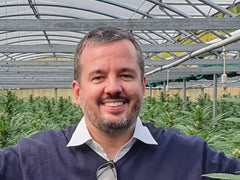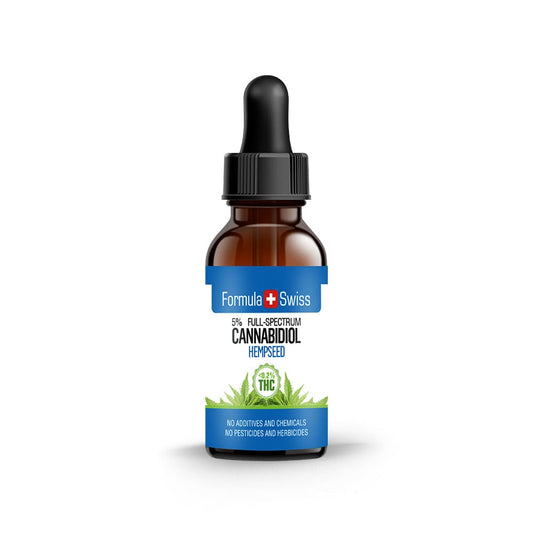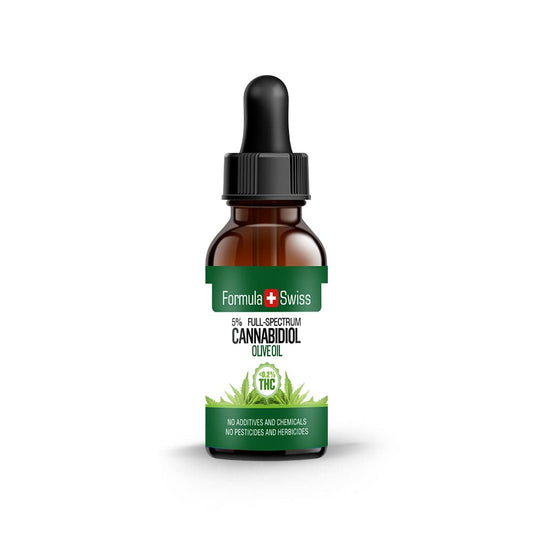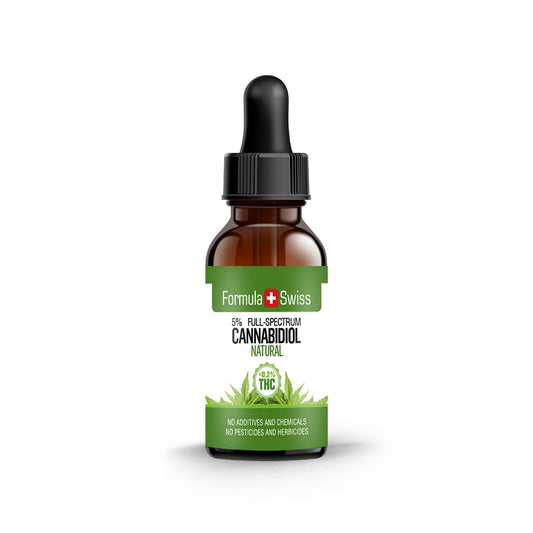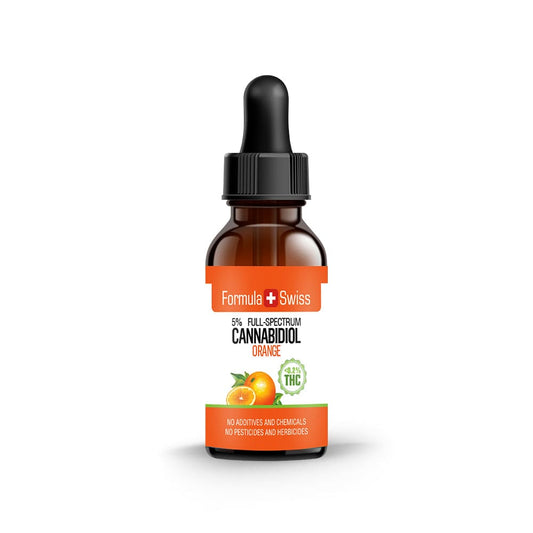The cannabis plant has been with humans for thousands of years. Over time, it has been used in a variety of ways, whether in ritual contexts, for recreational purposes or for practical use. Its history is long and complex, spanning cultures and generations.
According to the journal Vegetation History and Archaeobotany, cannabis likely originated in Central Asia, more specifically the north-eastern Tibetan Plateau. From there, the plant spread in both directions, eventually reaching South Asia. What contributed to this widespread distribution? Its adaptability, versatility and resilience in different climates.
The plant contains over 480 different compounds. One of the best-known is tetrahydrocannabinol (THC), which has psychoactive properties. Another is cannabidiol (CBD), which has received considerable attention in recent years. These and other cannabinoids interact with the body's endocannabinoid system, which is involved in various internal processes.
After over a decade of intensive work with CBD and hemp, I have witnessed how the public perception of cannabis has shifted. More and more people are showing interest in better understanding the plant beyond headlines and stereotypes.
For a long time, cannabis was stigmatised and subject to strict legal restrictions, primarily due to its psychoactive effects. This image has not completely disappeared, but the perception is changing. Ongoing research and a deeper understanding of the plant's complex structure are leading to a more balanced view of its place in modern society.
Prefer watching instead of reading? This video summarises the main points of the article:
Save up to 30% when you order your CBD oil today
Key takeaways
- Cannabis is a plant with a long history of use across various cultures, from spiritual to recreational purposes.
- It contains numerous compounds, including cannabinoids such as THC and CBD, which interact with the human endocannabinoid system.
- The main types are Cannabis sativa, Cannabis indica, and Cannabis ruderalis – each with distinct characteristics.
- The plant is dioecious, meaning there are both male and female plants, and it completes its life cycle within a year.
- Despite historical controversy, perceptions of cannabis are evolving towards a broader understanding of its diverse applications.
This article is provided for informational purposes only and does not relate to any of the products available in our webshop. For more information, please see our full disclaimer.
The cannabis plant
Cannabis is generally classified into three main types: Cannabis sativa, Cannabis indica, and Cannabis ruderalis. This classification is based on physical traits and growth behaviour.

Cannabis sativa
Cannabis sativa is known for its height and long, narrow leaves. These plants typically thrive in warmer regions and have a longer flowering period. Due to their structure, they are often chosen for agricultural or industrial purposes and are a key component of many hemp-based applications.
Cannabis indica
Cannabis indica grows more compactly, is shorter, and has broader, denser leaves. It is well-suited to cooler climates and has a shorter flowering period compared to sativa. Indica varieties are often preferred for cultivation in controlled environments with limited space.
Cannabis ruderalis
Cannabis ruderalis is less well known and is characterised by its small size, reduced branching, and fewer leaves. Its unique trait is the autoflowering ability, meaning it transitions to the flowering phase based on age rather than light cycle.
This trait makes ruderalis particularly interesting for breeding projects focused on developing strains with flexible flowering times.
Hybrid varieties
Through selective crossbreeding, hybrids have been developed that combine traits from sativa, indica, and ruderalis plants. These hybrids can be tailored to specific growing conditions, structural features, or cannabinoid profiles, for example, for use in topical products or industrial applications.
Chemical components of cannabis
The cannabis plant contains a wide range of naturally occurring compounds, including cannabinoids, terpenes, and flavonoids. The most widely known and studied cannabinoids are THC and CBD.
THC, or tetrahydrocannabinol, is the primary psychoactive element of the plant. It interacts with specific receptors in the body, particularly the CB1 receptor, which is associated with various neurological and biological processes.

CBD, or cannabidiol, is another well-known cannabinoid. Unlike THC, it is not associated with psychoactive effects. Ongoing research into CBD continues to explore potential applications and interactions with other plant compounds.
In addition to cannabinoids, cannabis also contains terpenes, aromatic compounds that shape the plant’s distinctive scent profile. Terpenes are believed to influence the overall experience with the plant.
A frequently discussed concept in scientific circles is the so-called “entourage effect”, which considers the interplay between cannabinoids and terpenes and how they may influence one another.
The endocannabinoid system
The endocannabinoid system (ECS) is a natural part of the human body and plays a role in regulating and responding to various internal and external influences. It consists of endocannabinoids, specific receptors, primarily CB1 and CB2, as well as enzymes that produce and break down these compounds.
The ECS is thought to be involved in a wide range of biological processes, including the sleep–wake cycle, mood, appetite signalling, memory functions, and aspects of reproduction. Scientists continue to research its mechanisms across different domains.
Ongoing studies aim to clarify how these interactions function and what they may reveal about the ECS as a whole.
Cannabis cultivation
Research into the endocannabinoid system (ECS) has increased significantly in recent years. Studies are examining its role in numerous physiological processes. Despite growing scientific interest, many aspects of its exact function in the human body remain the subject of ongoing investigation.
The cultivation of cannabis follows a structured process requiring a solid understanding of the plant’s growth cycle and environmental needs.
Typically, cultivation involves several stages: germination, where the seeds begin to sprout; the vegetative phase, marked by vigorous leaf and stem growth; the flowering phase, during which the characteristic flower structures develop; and finally the harvest, where mature plants are collected at the right time depending on their intended use.

Each phase has specific requirements for lighting, temperature, humidity, and nutrient supply.
| Phase | Light cycle | Nutrient needs | Environmental conditions |
|---|---|---|---|
| Germination | 18–24 hrs light | Minimal | Warmth and high humidity |
| Vegetative phase | 16–18 hrs light | High nitrogen content | Good airflow, moderate humidity |
| Flowering phase | 12 hrs light/dark | High phosphorus & potassium, reduced nitrogen | Lower humidity, support for flower structure |
| Harvest | Minimal light exposure | None | Cool, dark space for drying |
Order now and save up to 30% on your CBD oil purchase
Germination
Germination is the first stage in the development of a cannabis plant. During this phase, seeds are stimulated to sprout and form a seedling. This process typically takes between 24 and 72 hours.
During this time, seeds are usually placed in a warm, moist environment to encourage sprouting. Some growers use specially designed germination kits, while others prefer a simple method using damp paper towels in a consistently warm location.
Once germinated, seeds should be handled carefully to avoid damaging the delicate primary root. The proper planting technique involves placing the seed about half an inch deep into the chosen substrate, with the root pointing downwards.
Vegetative phase
The vegetative phase is characterised by vigorous structural growth. The plant focuses on developing stems, leaves, and branches necessary for subsequent stages. The duration of this phase can vary from several weeks to months, depending on growing conditions and genetics.
Intense lighting (typically between 18 and 24 hours per day) is important for promoting upright and expansive growth. Additionally, adequate nutrient supply, especially nitrogen-rich components, is crucial for healthy plant development.
Flowering phase
During the flowering phase, the cannabis plant begins to develop flower clusters. This stage is triggered by a change in the light cycle, specifically, 12 hours of light followed by 12 hours of darkness each day.
The plant’s nutrient requirements also shift during this phase. Nitrogen demand decreases, while phosphorus and potassium become more important as they support flower formation.
The flowering phase continues until the mature flowers are ready for harvest. The exact duration depends on the strain and cultivation conditions, but usually ranges between 8 and 12 weeks.
| Strain type | Average duration |
|---|---|
| Indica-dominant | 7–9 weeks |
| Sativa-dominant | 10–12 weeks |
| Ruderalis | 6–8 weeks (autoflowering) |
| Hybrid | 8–10 weeks |
Harvest
Harvesting marks the final stage of cannabis cultivation. The right time to harvest is critical to maximise the quality and yield of the flowers. If harvested too early, the flowers may not be fully developed; if harvested too late, the THC content may begin to degrade.
To determine the optimal timing, a magnifying glass is often used to examine the trichomes, tiny resin glands on the flowers. When most trichomes appear milky white and some are amber, this is generally considered the ideal time to harvest.

After harvesting, the flowers must be dried and cured. They are hung in a controlled environment to slowly remove moisture. This step enhances the aroma and quality of the flowers while preventing mould growth.
Indoor and outdoor cannabis cultivation
Cannabis can be grown either indoors or outdoors; each method offers specific advantages and requires different approaches.
Indoor cultivation
Indoor cultivation allows for full control over environmental conditions, including light cycles, temperature, humidity, and nutrient supply. This level of control makes it possible to tailor the growing environment to the specific needs of particular cannabis strains.
However, setting up an indoor facility often requires a larger initial investment. Key components include artificial lighting systems, air filtration, ventilation units, and environmental control devices. Ongoing operational costs, especially electricity, can also be significant.

Outdoor cultivation
Outdoor cultivation is generally more cost-effective to implement. By relying on sunlight and natural environmental conditions, it is possible to grow large, robust plants.
The open environment offers ample space for root expansion and vertical growth. However, it also presents risks such as unpredictable weather, pest infestations, or plant diseases. Successful outdoor cultivation depends on a good understanding of local climate conditions and proper timing.
Order and enjoy up to 30% off your CBD oil purchase
Challenges and solutions in cannabis cultivation
Successful cannabis cultivation requires ongoing attention to plant development and timely action to address any emerging problems. Regardless of the method used, indoor, greenhouse, or outdoor, maintaining optimal growing conditions is key to achieving high-quality results.

Nutrient management
A frequent challenge in cultivation involves nutrient imbalances. Cannabis plants rely on precise ratios of macro- and micronutrients, and either deficiencies or excesses can hinder development.
Symptoms such as discoloured leaves, slowed growth, or poor flower formation often indicate nutritional issues. Regular testing of soil or growth medium, combined with appropriate adjustments to feeding schedules, can help maintain nutrient stability.
Pest and disease control
Growers also contend with pests and pathogens. Common threats include insects, fungal infections, and bacterial contamination. Indoor environments allow for greater control sanitation, air circulation, and environmental monitoring can significantly reduce the risk.
In outdoor settings, growers often rely on preventative methods and, where necessary, certified organic pest deterrents that comply with agricultural standards.
Resource awareness
Cultivation requires a solid understanding of plant biology, climate control, and input management. Access to reliable information and the appropriate tools can significantly improve results. While challenges are inevitable, they can be addressed effectively with observation, preparation, and informed techniques.
Personal perspective
In my years of working within the CBD and hemp industry, I’ve found cannabidiol (CBD) to be one of the most compelling aspects of the cannabis plant. Its complex structure, non-intoxicating nature, and broad potential for application have positioned it at the centre of both scientific research and industry conversations.
From seed selection to extraction, each stage of production reveals something new about the compound's versatility and how its quality can vary depending on agricultural and processing standards.
Having managed and observed numerous cultivation and extraction operations, I’ve come to appreciate the importance of precision and consistency when working with CBD.
Variations in plant genetics, soil quality, and extraction methods can significantly affect the profile and concentration of cannabinoids present. This level of detail and control is essential in maintaining a reliable product and advancing the understanding of CBD’s role within the broader cannabis context.
Don’t miss out—save up to 30% when you purchase CBD oil today
Frequently asked questions
What is cannabis used for?
Cannabis is used for a variety of applications. It may be involved in research, industrial uses, or as part of structured programmes. In some regions, certain parts of the plant are grown for personal interest or permitted industrial use.
What does it mean to be high on cannabis?
The term "high" typically refers to the psychoactive effects some individuals may report after exposure to THC, the primary intoxicating compound in cannabis. These effects can vary and may include altered perception, mood changes, or changes in sensory awareness.
Is CBD and cannabis different?
CBD (cannabidiol) is one of numerous compounds naturally present in the cannabis plant. Unlike THC, CBD does not produce intoxicating effects. It is commonly sourced from industrial hemp varieties selected for their low THC content and used in a variety of applications.
What are the effects of cannabis?
The reported effects of cannabis vary and depend on multiple factors, including the chemical profile of the specific plant variety and method of use. Some report changes in mood or perception, while others may experience different responses. Effects can differ between individuals and are subject to various influences.
What are the components of cannabis?
Cannabis contains more than 100 identified cannabinoids, including THC and CBD. It also contains terpenes, which contribute the aroma. The composition of these elements can differ across plant varieties.
What are the long-term effects of cannabis?
Research into the long-term effects of cannabis is ongoing. Some studies suggest that frequent exposure, especially at a young age, may affect memory or learning. Individual outcomes can vary based on many factors, including frequency and method of exposure, genetic background, and age.
How is cannabis used?
Cannabis may be applied in various formats depending on industry guidelines and intended use. These formats include topical products or applications within industrial or scientific contexts. Approaches vary based on established practices and specific application requirements.
What are the different types of cannabis?
The cannabis plant is typically categorised into three groups: Cannabis sativa, Cannabis indica, and Cannabis ruderalis. Each group may differ in growth characteristics, cannabinoid profiles, and uses in the industry.
Difference between cannabis, marijuana and hemp


